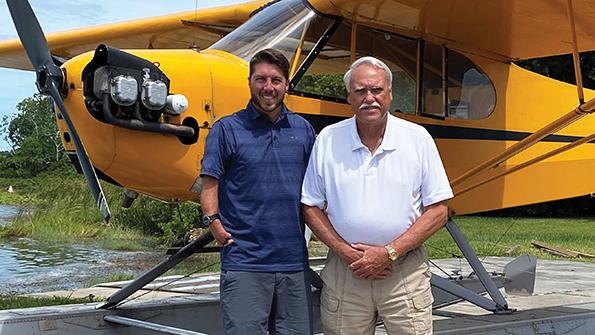
Family names have long comprised general and business aviation royalty, including Cessna, Jeppesen, Swearingen, Showalter, Bell, King, Lear, Piper and Beech, among the many.
However, after the exits of their impassioned founders, the harsh realities of business competition and economic cycles often took hold, and those familiar names were either subsumed into larger entities or simply disappeared.
- A family business soon turning 60
- 25,000 water wing grads
- Low and slow and stick-and-rudder
Yet there are surnamed entities in which the excitement of the founder continues among the progeny who assumed the legacy. One example still shining brightly is Brown—Jack Brown’s Seaplane Base, that is.
Founded eponymously in 1963 by a World War II pilot of Grumman and Consolidated seaplanes, the real purpose of the fixed base operation was to expose other licensed airmen to the challenges and pleasures of flying floatplanes. And so it remains nearly six decades later.
By the time Jack Brown flew west into the sunset in 1975, the training base in Winter Haven, Florida, was well established, and his eldest son, Jon, well prepared to lead. Today, Jack Brown’s is known globally as the place for pilots to get their feet wet.
According to Steve McCaughey, executive director of the Seaplane Pilots Association, there are roughly 80 schools in the U.S. where pilots can earn an Airplane Single-Engine Sea (ASES) rating, but Brown’s accounts for more graduates than all the others combined. In numbers, the base trains some 500 pilots annually. And according to Jon Brown, it experienced no student falloff in 2020 even though the COVID-19 pandemic blocked participation by international pilots, who typically account for about 20% of the total.
To accommodate splash seekers, Brown’s employs a fleet of five Piper J-3 Cubs, a Super Cub (with a second to join this summer) and a Maule M7, all fitted with straight, nonamphibious, floats. While the Cubs date back to the 1940s, Brown’s regularly cycles each of its aircraft through an in-house rebuilding process. The company also fielded a series of rare, twin-engine Seabees for years, but Brown says they proved to be maintenance-intensive, and he sold them all.
The ASES course involves ground school and 5 hr. of dual instruction and concludes with a checkride—essentially, a weekend. The cost is $1,700-2,700, depending upon the aircraft used; any additional instruction is billed at an hourly rate. Aircraft rental for the checkride and the examiner’s fee are extra. Transportation to and from Florida, housing and food are the trainee’s responsibility.
Brown attributes his outfit’s popularity to several factors, including Florida’s year-round flying weather and the abundance of lakes in the area. Most important, he says, is Brown’s decades-long focus on teaching float flying exclusively and its mastery of a process that has so far produced 25,000 water wingers.
In addition, notes Ben Shipps, Jon Brown’s son-in-law and designated successor, is the appeal of back-to-basics, stick-and-rudder flying embodied in the course and aircraft. He says Brown’s students, who include airline, military and corporate pilots along with Private Pilot Certificate holders—and occasional celebrity pilots such as musical icons Jimmy Buffett and Alan Jackson—clearly savor the chance to fly low and slow with doors open and minimal instrumentation.
“They’re taking a step back in time,” he says, and quite probably reliving the sensations that drew them to aviation in the first place.
Helping to facilitate those experiences is Brown’s corps of full- and part-time instructors, which fluctuates from seven to 10, depending on student load. Shipps, who earned his ASES rating at Brown’s and joined as an instructor in 2011, says the overall setup could accommodate even more trainees, but Brown’s chooses to limit the number to maintain its personal focus on each.
Brown says there are no plans to expand the Florida operation or set up bases elsewhere, lest cost control or program quality be put at risk. Besides, the father of three grown daughters notes, Brown’s geriatric Cubs “put a couple of kids through college.” To which Shipps, now raising three with wife Alison, Jon’s youngest daughter, quickly adds, “And probably a couple more.”
He then closed by saying, “Who knows? Maybe one of them will be the fourth generation” and will keep the Brown light shining brightly, reflecting in the water, welcoming all.


